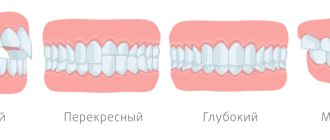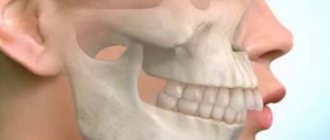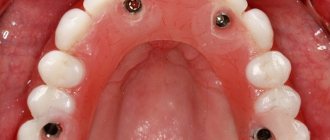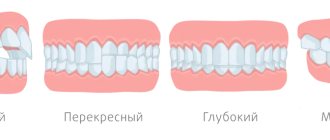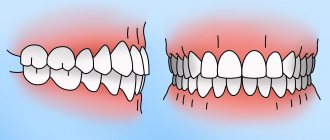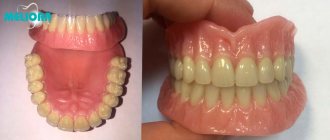Problem: a man turned to Dial-Dent to cure caries and restore missing teeth. Dental restoration through implantation was complicated by the fact that, due to the long-term absence of some teeth, neighboring teeth had moved, gaps appeared between the teeth, and some teeth had changed their inclination and height. Orthopedic dentist S.V. Zukor drew up a comprehensive treatment plan, which included correcting the bite, re-treating the canals of the teeth, treating caries, restoring teeth with pin inlays, installing dental implants and prosthetics on implants, and restoring worn-out teeth with crowns. This treatment plan seemed too extensive and unreasonable to the patient, and he disappeared from the sight of the clinic for several years. After 7 years, the patient finally decided that the problem with his teeth really needed to be solved in full, since partial measures did not give any improvement, and again came to the Family Dental Clinic, having not found such an integrated approach and coordinated team work of doctors in other places.
Solution: removal of failing teeth, treatment of caries and re-treatment of dental canals with a microscope, neuromuscular correction of bite height, bone grafting and installation of dental implants (a total of 8 Astra Tech implants), prosthetics with ceramic crowns of all teeth taking into account the physiological occlusion.
Commentary by the chief physician of Dial-Dent, orthopedic dentist S.V. Zukora: “I have been involved in complex dental treatment for more than 25 years, and in my practice there are quite often situations when patients do not immediately decide to undergo dental treatment. The decision takes months or even years to mature. This arises because most often a person treats teeth symptomatically, solving a problem that is obvious: a filling fell out - a new one was put in, a tooth hurt - it was removed or treated, etc. No one wants to solve bite problems globally, because it is long, scary, expensive, etc. And so on year after year. The situation is getting worse: fillings are falling out more and more often, teeth are being destroyed, and tooth wear is becoming obvious. And only then does a person slowly begin to come to terms with the idea that it is necessary to deal with the mouth in a comprehensive manner. In the case discussed in this paper, the patient decided to agree to a comprehensive full mouth prosthetic plan over a period of 7 years - a record in my practice!
We held our first consultation in 2012. Even then it was clear that simply replacing a few rotten teeth with implants would be wrong! In addition to replacing teeth, it is necessary to deal with prosthetics for all remaining teeth too! It was necessary to put crowns on all the teeth in order to change the irregular shape of the teeth and make the bite more physiological by raising its height, since the teeth were significantly worn out. The patient came to get a couple of implants, and I offered to restore all his other teeth too. The patient was extremely unprepared for such a turn of events! I took the information with hostility and left dissatisfied with the consultation. Very often the patient is not satisfied with the consultation when the information received from the doctor does not agree with his (her) picture of the world. And that's okay. 7 years passed and the patient came again! But now it was a completely different degree of perception of the situation! During this time, the patient had already tried to do something in other clinics. Nothing good came of this. And gradually the understanding came that the path I proposed at the first consultation - complete reconstruction of the bite with restoration of all teeth - was the most correct!
So, the first consultation is in 2012, and the second consultation and start of work is in 2021.”
Planning treatment and dental prosthetics
Long-term absence of teeth has led to the fact that neighboring teeth have shifted - the chewing teeth on the lower jaw are strongly tilted towards the missing teeth; the upper teeth, due to the fact that there are no antagonists (opposite teeth) below, began to move down, and the lower central teeth moved apart, and significant gaps formed between the teeth. The jaw bone in some places has become thinner than necessary for dental implants. The reason could be either a prolonged absence of load, or improper removal of chewing teeth or an inflammatory process. In any case, bone grafting is necessary to increase the thickness of the bone.
The photo shows the main problems that dentists faced:
The teeth were significantly worn down, causing the bite height to decrease. This not only disturbed the aesthetics of the teeth, but also caused headaches and overload of the temporomandibular joints (pain and clicking appeared in the joints). To restore health, it was necessary to raise the height of the bite. The height of the bite was determined using neuromuscular diagnostics, which analyzed the work of the muscles and the trajectory of the lower jaw.
You can change the height of your bite by restoring teeth with crowns. But all teeth need to be restored with crowns. Crowns on the chewing teeth will keep the lower jaw in a physiological position, and crowns on the front teeth are necessary to close the gap between the teeth.
The photo shows how much the crowns of the upper teeth need to be lengthened (the lower ones also need to be lengthened so that there is an overlap):
Based on the situation, it would be correct to first correct the bite, straighten the dentition and create space for normal prosthetics. However, the patient asked to find an alternative, since the treatment would be lengthy, and he did not want to increase the duration of treatment with braces.
A joint consultation of an orthodontist (a specialist in correcting bites), a neuromuscular dentist and an orthopedist (a specialist in dental prosthetics) helped to develop an optimal treatment plan without braces. An option without correcting the bite is possible, since all teeth will be involved in prosthetics, and the shape and inclination of the teeth can be changed using dental crowns. The result without correcting the bite will not be ideal, but completely optimal in terms of function and aesthetics.
According to the treatment plan, dental prosthetics will be aimed at restoring missing teeth and improving aesthetics, and all this in the correct physiological occlusion, in which the entire body will work without failures.
Treatment plan:
- Comprehensive hygienic preparation – removal of plaque and tartar.
- Treatment of caries, treatment of tooth canals with a microscope, restoration of damaged teeth with pin inlays.
- Removal of failing teeth.
- Installation of dental implants (1 on the upper jaw and 7 on the lower jaw) with bone grafting. Dental implantation under sedation, all in one operation.
- Normalization of bite height (neuromuscular correction: wearing an orthotic to fix the correct bite height and myostimulation to restructure the functioning of the masticatory muscles).
- Dental prosthetics with ceramic crowns in a physiological occlusion.
- Development of a program of preventive monitoring and hygiene support.
Violation of facial symmetry
Some facial asymmetry is the absolute norm for most people and, to a certain extent, does not affect the perception of a person’s appearance. Uneven development of the upper and lower jaws, as a rule, leads to the formation of a noticeable flaw. In this case, first of all, the correct overlap of the lower dentition with the upper one is disrupted due to the lateral displacement of the jaws relative to each other.
People with a crossbite are forced to chew primarily on one side, which leads to faster wear of the teeth in that area. A decrease in the height of dental crowns due to abrasion of the enamel gradually increases the existing asymmetry.
Professional dental hygiene to prepare for complex treatment
Before tooth extraction or dental treatment begins, all Family Dental patients undergo professional oral hygiene. The Air Flow method completely removes dental plaque, and ultrasound removes tartar. On clean teeth, areas affected by caries, enamel cracks and other problems are clearly visible. Removing tartar restores normal blood circulation to the gums. Reducing the microbial load after professional oral hygiene improves tissue restoration after tooth extraction or other surgical procedures.
The cost of comprehensive professional oral hygiene is 6,900 rubles.
Dental treatment with a microscope
Before dental prosthetics, if necessary, caries treatment and dental canal treatment are carried out so that the teeth under the crowns do not get sick. In this case, it was necessary to treat three teeth in which the canals had previously been filled. The canal filling was unsatisfactory, so Dial-Dent specialists could not guarantee the health of such teeth under crowns. Healthy roots of the upper teeth are important not only for the longevity of the prosthesis, but also for the health of the ENT organs. Since the roots of the upper teeth are closely connected to the maxillary sinuses, inflammation in the roots of the upper teeth can cause inflammation in the sinuses - sinusitis.
After dental treatment with a microscope, the Dial-Dent clinic guarantees the health of the roots of the teeth and surrounding tissues and the longevity of the dental crowns.
Commentary by the chief physician of Dial-Dent, orthopedic dentist S.V. Tsukora: “Remember! When installing ceramic crowns, there is no need to remove the nerve from the tooth. At Dial-Dent we make very thin ceramic crowns, and the tooth is prepared using a special technology; these two factors allow you to leave the tooth under the crown alive. This is a big health benefit!”
The cost of re-treatment of tooth canals with a microscope ranges from 16,500 to 27,500 rubles.
Reasons for the development of anomalies
The main reasons for increased bite height are:
- tooth surfaces have changed;
- the habit of chewing food only on one side;
- teeth grinding problem;
- partial adentia without row restoration;
- lack of minerals, poor diet;
- illiterate previous prosthetics
Treatment of malocclusion largely depends on the cause of the anomaly. Therefore, during the initial examination, our orthopedic doctors prescribe a number of studies and conduct a survey of the Patient to identify such factors. This allows you to accurately select correction methods and make treatment effective.
Tooth extraction
On the lower jaw, two chewing teeth were strongly tilted, so that they interfered with normal prosthetics. In addition, the teeth were destroyed by caries. These two teeth were removed. The remains of severely damaged teeth were also removed.
Commentary by the chief physician of Dial-Dent, orthopedic dentist S.V. Tsukora: “The teeth could not be removed if the patient agreed to correct the position of the teeth with the help of braces. The treatment period would have increased by 1.5 years, but the teeth would have remained the same. Giving up orthodontics forced us to look for other treatment options, and removing teeth and replacing them with even crowns on implants was the best way out of the situation.”
The cost of tooth extraction starts from 2000 rubles.
Mock up
A complete mock up is very useful for checking the functional and aesthetic result at the same time.
In addition, the precision and aesthetics of bisacrylic resin (luxatemp star, DMG) help to win over the patient.
Fig.8 Following the concept of a full mock up, the posterior part of the mock up is used as a reference for subsequent preparation and creates the necessary space for the occlusal veneer.
Fig. 9 Almost no preparation is required to install an occlusal veneer. All you need is a mark so that the technician can accurately recreate the boundaries of the restoration. It is necessary to make a thick edge of the veneer to avoid fracture or crack.
Fig. 10 Each veneer is fixed one after the other with a flowable dentin body shade composite (enamel HRi flowable UD1) to reduce the appearance of the transition. In addition, some subtle “waves” were created to enhance the aesthetics of the restoration.
Fig. 11 Final view of the restoration performed with emax LT A1. If the patient is not satisfied with the aesthetics, cheek veneers may be offered.
Fig. 12 View of a one-piece lithium disilicate veneer from the palatal side. Thanks to the translucency of the material, good aesthetics are created along with functionality.
Dental implantation under sedation
Dental implantation and bone grafting in areas where the bone width was not enough (bone grafting) were carried out under sedation, that is, the patient was in a medical sleep and did not feel anything. Sedation helps to avoid anxiety and anxiety during surgical interventions, and to do a large amount of work in one operation. In this case, 8 dental implants were installed under sedation and bone grafting was performed.
Astra Tech dental implants were installed, which are distinguished by the highest reliability, biocompatibility and quality of all components. The clinic has been working with Astra Tech dental implants for more than 15 years, completely trusting them.
The cost of installing one Astra Tech implant at Dial-Dent, including the implant itself, is 38,900 rubles.
The cost of sedation is 12,500 rubles for the first hour, and 6,000 rubles every next 30 minutes.
A surgical template was used to install dental implants. The doctor calculated in advance the direction, inclination, and depth of installation of the implants. The technician made a special pad - a surgical template, which helped install the implants in exactly the intended places. With a surgical template, surgery time is reduced and the quality of implant placement is improved.
How long does tooth crown lengthening take?
Surgical lengthening of teeth is performed in just a day, regardless of the amount of work. Each tooth usually requires about ten minutes.
After a couple of weeks, or even earlier, the temporary dentures are fixed, and the correct gingival contour is formed around them.
After 3-5 months, permanent structures are installed. In general, orthodontic treatment, coupled with the retention period, takes 8-12 months.
Veneering and installation of crowns without surgery require only a few days.
Neuromuscular bite correction
Neuromuscular diagnostics carried out using a computer myograph before the start of treatment showed that the patient’s bite height was insufficient. A low bite could cause frequent headaches and clicking in the joints. It is known that the position of the lower jaw has a huge impact on posture, head position and overall well-being. Incorrect position of the lower jaw can cause headaches, dizziness, snoring, sleep apnea, and neck pain. A study using a computer showed how much the height of the bite should be raised so that there is no damage to health - blood vessels are not pinched, joints work correctly, muscle spasms and muscle overload do not occur.
Before installing crowns of the required height, it was necessary to rebuild the functioning of the dental system, to allow the muscles and joints to get used to the new position of the lower jaw. For this purpose, the patient wore a special mouthguard - orthotic, and also underwent several sessions of myostimulation. After the muscle function had been restructured, permanent crowns could be installed.
The stage of neuromuscular correction is necessary so that new dental crowns do not cause discomfort, so that overstrain does not occur in the muscles and joints.
Main types of malocclusion
Dental practice shows that not all patients have the correct bite. Situations where teeth are positioned incorrectly are much more common. Let's look at the most common pathologies:
Open bite
The lateral and frontal teeth do not contact each other when closing. In this case, large gaps are observed between the teeth. A noticeable external sign of such a problem is that a person’s mouth is constantly slightly open, the chin is lowered, while the chin and nasolabial folds are strongly smoothed out. When a patient has such a problem, there is a high probability of developing caries and increased tooth wear.
Traumatic bite
This problem is also called disocclusion. With it, the upper incisors overlap the lower ones. There is significant protrusion of the jaw. Externally, the problem can be identified by two signs:
- Eversion of the lower lip.
- Shortened lower third of the face.
The problem needs to be fixed as soon as possible because there is a possibility of improper load distribution.
This stimulates the emergence of many diseases - from gingivitis to periodontitis and stomatitis.
Patients also often complain of headaches and difficulty biting and chewing food.
Prognathic occlusion
This problem also occurs under the name of distal bite. It is characterized by protrusion of the upper frontal incisors over the lower ones. There is also a sagittal fissure.
Among the main external signs of the problem:
- Strong protrusion of the nose forward.
- Upper lip and jaw extended forward.
- Slouch.
Many patients complain of difficulty swallowing and chewing food. There are problems with diction, loss of teeth and other potential difficulties.
Mesial bite
The main characteristic is a strong protrusion of the lower jaw forward. Dentists often see many associated problems. Among them are the following:
- Speech defects.
- Diastema.
- Diaeresis.
- Dystopia.
Often it is precisely this defect that prevents doctors from performing implantation normally.
Crossbite
In this case, there is an overlap of one or more lower teeth with the upper ones. The pathology can be localized both in the anterior and lateral sections.
External manifestations may be different:
- Chin displacement.
- Pronounced facial asymmetry.
Most often, the problem occurs in childhood; untimely loss of baby teeth can also be a cause. If the problem is not addressed, it will lead to gradual thinning of the gum tissue, improper distribution of the load on the jaw, severe tooth wear, and pain in the temples.
Dental prosthetics with ceramic crowns, including prosthetics on implants
After completing the preparation - restructuring the bite, engrafting the implants and re-treating the teeth, you can begin the final stage - dental prosthetics with ceramics.
First, we selected the color of the restorations.
The teeth were prepared for crowns, and for prosthetics on implants, individual ceramic abutments were made - bases for crowns that replace your own ground teeth.
The teeth were covered with temporary crowns while the ceramic crowns were made.
While the patient was wearing temporary crowns, he was able to verify the comfort of the new bite and finally get used to the new position of the jaw.
Ceramic crowns are made in the Dial-Dent dental laboratory taking into account the correct bite height. The photographs show crowns on a dental model in the laboratory.
After installing dental crowns, the man finally gained a full smile, and the functionality of his teeth was completely restored. The patient noted an improvement in general health, absence of headaches and clicking in the joints.
Measurement methods
Anatomical method
The use of this method of measuring bite height is aimed at identifying the physiological transformation of the lower part of the facial zone.
Calculation of central occlusion using this method is based on identifying features of facial anatomy.
A decrease in bite height is expressed in the following points:
- sunken lips;
- increasing the depth of nasolabial folds;
- moving the chin forward;
- reduction in the height of the lower part of the face.
When using the anatomical method, you need to pay attention to the following points:
- the lips should be mobile and in contact with each other along the entire length without effort;
- the functionality of the orbicularis oris muscle should be high;
- The elevation of the corners of the mouth and the severity of the nasolabial folds should be determined.
Experts in the field of dentistry note that this research method is quite subjective , so it is practically not used at present.
Information content of teleroentgenograms in orthodontics in lateral and direct projection.
This material is devoted to modern diagnostic methods in dentistry.
Here https://orto-info.ru/ortodonticheskoe-lechenie/podgotovitelnyiy-period/miogimnastika.html we’ll talk about the effectiveness of myogymnastics in orthodontics.
Anatomical and physiological
The anatomical and physiological method for determining the height of the bite is based on identifying the height of physiological rest.
The technique for performing the procedure is as follows:
- The dentist places two marks on the patient's skin - at the base of the nasal septum and in the central part of the chin.
- Next, the patient is asked to make a couple of swallowing movements or pronounce several phrases, the pronunciation of which involves the lips.
After completing these actions, the lower jaw row comes to a state of rest. At the same time, the lips touch each other without tension, without stretching or sinking, and the nasolabial folds are moderately visible. - The dentist, using a special ruler with divisions, measures the distance between two points that were previously applied to the patient’s skin.
- Special templates with occlusal ridges are placed in the patient’s oral cavity, which must be lightly bitten.
- The specialist re-measures the distance between the points located on the nose and chin. The resulting indicator determines the occlusal height, which normally should be less than the previously determined height of physiological rest by 2-3 mm.
If, when determining the height of the bite, the occlusal height is equal to the indicator determined at rest, then the specialist concludes that the bite is elevated. Conversely, when the occlusal distance exceeds the resting height by more than 3-4 mm, this indicates an underbite.
After determining the bite index, the specialist removes or increases the height of the lower bite ridge until the occlusal height reaches the norm.
In this case, the dentist evaluates the condition of the tissues around the mouth. When the physiological occlusion is restored, the contours of the lower part of the face are normalized, the corners of the mouth are raised, and the nasolabial folds become less pronounced.
The result of complex dental prosthetics with ceramics
The photographs show the condition of the teeth before and after prosthetics.
The height of the bite is increased, worn edges are restored and the gaps between teeth are closed due to the correctly designed shape of dental crowns.
The integrity of the dentition has been restored.
But this is only the external side of the work done. X-rays show how much the condition inside has changed.
A panoramic photograph of the teeth taken before the start of treatment in 2012 shows the problems that dentists had to solve in addition to missing teeth and severe destruction of individual teeth:
Picture after root canal treatment, removal of some teeth and installation of dental implants (2019):
The distant teeth serve as supports for now, but after prosthetics they will be removed.
Panoramic photo after completion of treatment and dental prosthetics (2020):
The cost of dental treatment and prosthetics amounted to 2,480,000 rubles. The patient knew the full cost from the moment the treatment plan was drawn up and the estimate was signed. Some people are scared that such a large amount is announced at once, but during the course of treatment there are no surprises in the form of additional expenses. Since payment is made in stages, and the deadlines for all stages are set in advance, you can easily plan your budget. Part of the cost of treatment can be returned by taking advantage of the right to a tax deduction. The clinic administration helps prepare all the necessary documents.
Wax up
Wax up - Wax up of teeth is performed by a technician (Hilal Kudey, Bodrum, Turkey) and closely follows clinical observations and recreates lost volume.
Fig.5 To perfectly move the wax up in the mouth and increase the accuracy of the mock up restoration, wax up is 3D printed from .stl files to obtain the required hardness. This template is lined with silicone material to increase adhesion to the existing template and to prevent swelling during insertion into the mouth.
Fig.6 This 3D printed template is made of bisacrylic plastic (luxatemp star, DMG) and placed in the oral cavity to create a complete mock up. A new smile line is visible in the anterior and posterior regions, as expected during the registration of the bite height.
Fig.7
Dial-Dent specialists who took part in this work:
- Orthopedic dentist S.V. Zukor – diagnostics, treatment planning, dental prosthetics with ceramics, including prosthetics on implants.
- Implant surgeon V.P. Alaverdov – tooth extraction, dental implantation under sedation, bone grafting.
- Anesthesiologist D.V. Sidorov – consultation before sedation, monitoring the patient’s condition throughout the entire operation.
- Orthodontist O.A. Baranova – consultation on bite correction.
- Neuromuscular dentist A.V. Galeev – neuromuscular diagnostics and treatment.
- Dentist-endodontist Yu.A. Borisova – dental treatment with a microscope, re-treatment of dental canals, dental revision with a microscope.
- Dental hygienist E.P. Smirnova – comprehensive hygienic preparation before dental treatment, hygienic support, development of an individual oral care program.
- Dental assistants M. Erkimbekova, L. Kharlamova, A. Antoshkina.
See other examples of the work of Dial-Dent specialists here.
Make an appointment for a consultation on dental prosthetics by calling +7-499-110-18-04 or using the form on the website. You can ask questions about dental prosthetics to the chief doctor of the clinic, Sergei Vladimirovich Tsukor, at
What to do if you have a bad bite
If you have problems with your bite or incorrect position of your teeth, you should definitely consult a doctor. The orthodontist will quickly develop the correct solution to the problem and tell you what to do so that you can quickly correct the position of the jaw.
Our clinic employs experienced orthodontists. They are ready to correct bite problems of any complexity. Affordable prices and guarantees of quality results attract clients from different cities - Khimki, Kurkino, Novogorsk and others. To sign up for your first free consultation, leave a request on the website.


